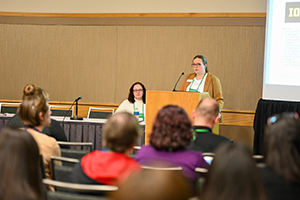
By Lisa Erck, Associate University Registrar & Law Registrar at the University of the Pacific
In a Monday afternoon session at the AACRAO's 107th Annual Meeting, presenters Amanda Steele-Middleton, University of Delaware, and Becky Keogh, University of Iowa, shared how their institutions implemented flexible work arrangements after working remotely under the pandemic. Their universities sought to enhance staff management, schedules, workload, and solve campus space challenges. Additionally, their universities leveraged the benefits of flexible arrangements to improve employee well-being, productivity, collaboration, and retention, while modernizing their delivery of student services.
Pre-Pandemic and Present
The presenters shared an overview of their campus from sizes, colleges, programs, total student enrollment, and employment numbers. In addition, they provided a comparison of any remote or flexible work, office coverage, and general approach to operational functions. Specifically, the pre-pandemic pattern of no option for fully remote work, limited remote for professional staff, high student contact for in-person and paper forms. In comparison, Amanda shared that at the University of Delaware, with a student population of over 23,000, their current state upon campus reopening is one with staff rotating schedules for in-person coverage 1-2 days per week. In addition, the primary form of student inquiries is now via phone and email, with many enhancements to online student forms and electronic services.
Similarly, Becky shared that at the University of Iowa, with a student population of over 31,000, the current state upon reopening is 45% fully remote, 37% hybrid, and 18% fully in-person. In addition, the university has implemented a Future of Work process, including coordinating decision-making within departments. Furthermore, forms and services improved with electronic virtual options. Lastly, students have continued to request grad services and advising meetings virtually. Collectively, both universities have leveraged flexible and hybrid work options as an employee retention strategy.
Key Factors of Evolution and Expansion
Amanda explained their approach to considering a remote/hybrid/flexible work environment required addressing some key questions, such as:
Who is driving the change?
What do employees want?
What does the organization need?
What are the relevant university policies?
What are the guiding principles?
How can we leverage data?
How do we coordinate?
How do we communicate?
She shared how Human Resources encouraged an experimental year. Most employees wanted a hybrid model. Employees felt they had proved they were capable. Their data had shown increased productivity, better work-life balance, and increases in wellness-related behaviors. The flexible approach also provided an opportunity to reallocate office spaces to solve a growing space shortage problem.
Implementation
Amanda described essential steps for success, utilized predictable and structured work schedule rotations, set a minimum of 4 in-person staff per day, and developed a cross-training plan for all staff. Historically their office had high in-person service interactions, which have reduced to one to two people coming in per day. In addition, they created well-defined criteria outlining both the staff member's role and the supervisor's role in developing a successful agreement.
Becky expressed that implementing flexible work arrangements required supervisors to "up their game." She found the ability to embrace change and learning was essential. She applied steps to put systems in place, increase communication, and expand work documentation. She received positive staff feedback highlighting the benefits of online meetings using captioning as a method for enhanced inclusive employee experiences.
Benefits
Becky shared their university's definition of workplace flexibility as "one that considers how, when, and where people do their best work." The purpose is to provide balance and flexibility and encourage their staff's highest level of work. Most importantly, increasing retention, commitment, and productivity. Notably, data has shown their staff is more engaged at work now than before the pandemic. The staff has experienced increases in cohesion and a higher engagement in teams. They currently have 1,800 remote and hybrid arrangements. The implementation has facilitated co-working in offices and shared hoteling style workspaces such as their CoWork Commons. The university has increased available space on campus that was desperately needed and increased other opportunities for expansion. Overall, their university has experienced increased innovation and creativity with improved team dynamics.